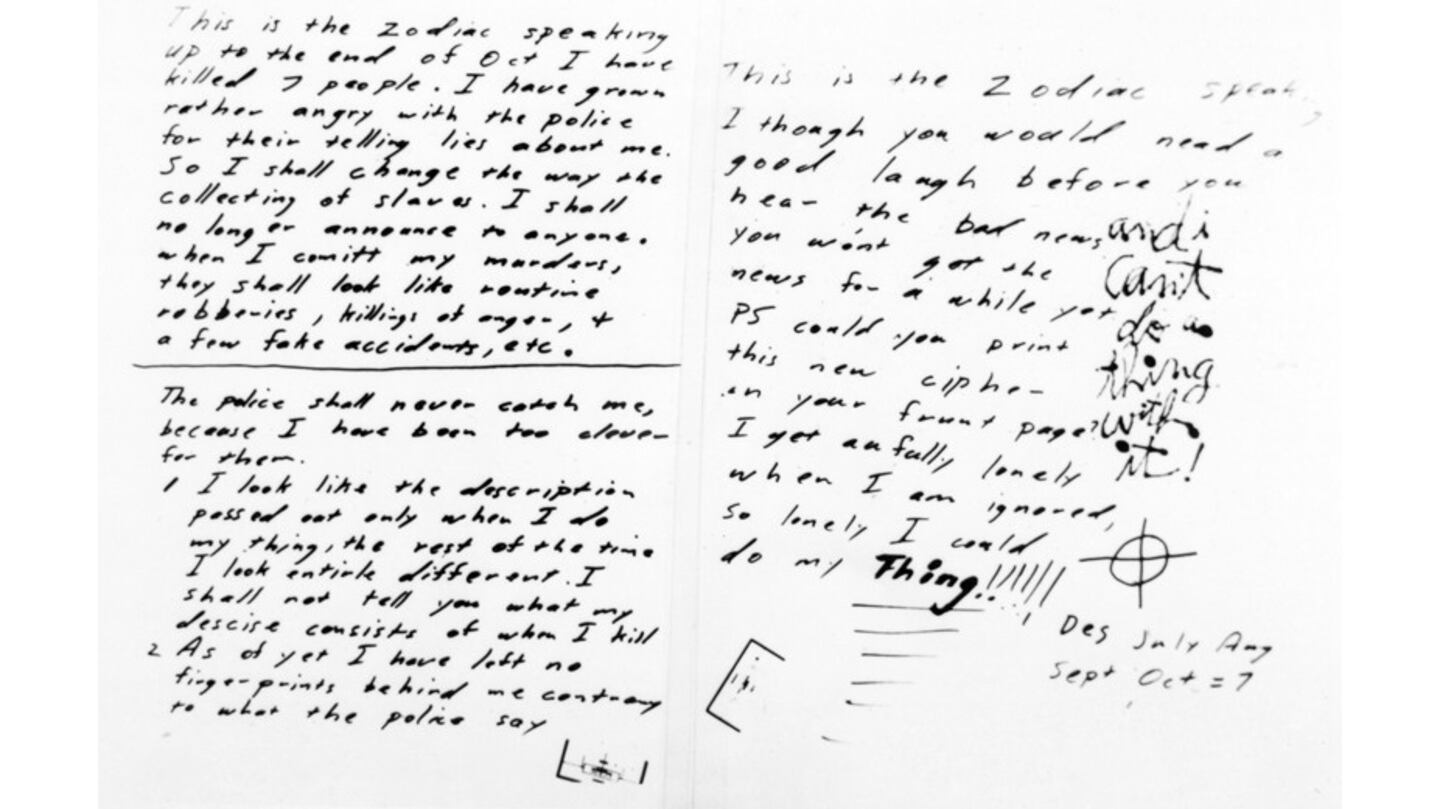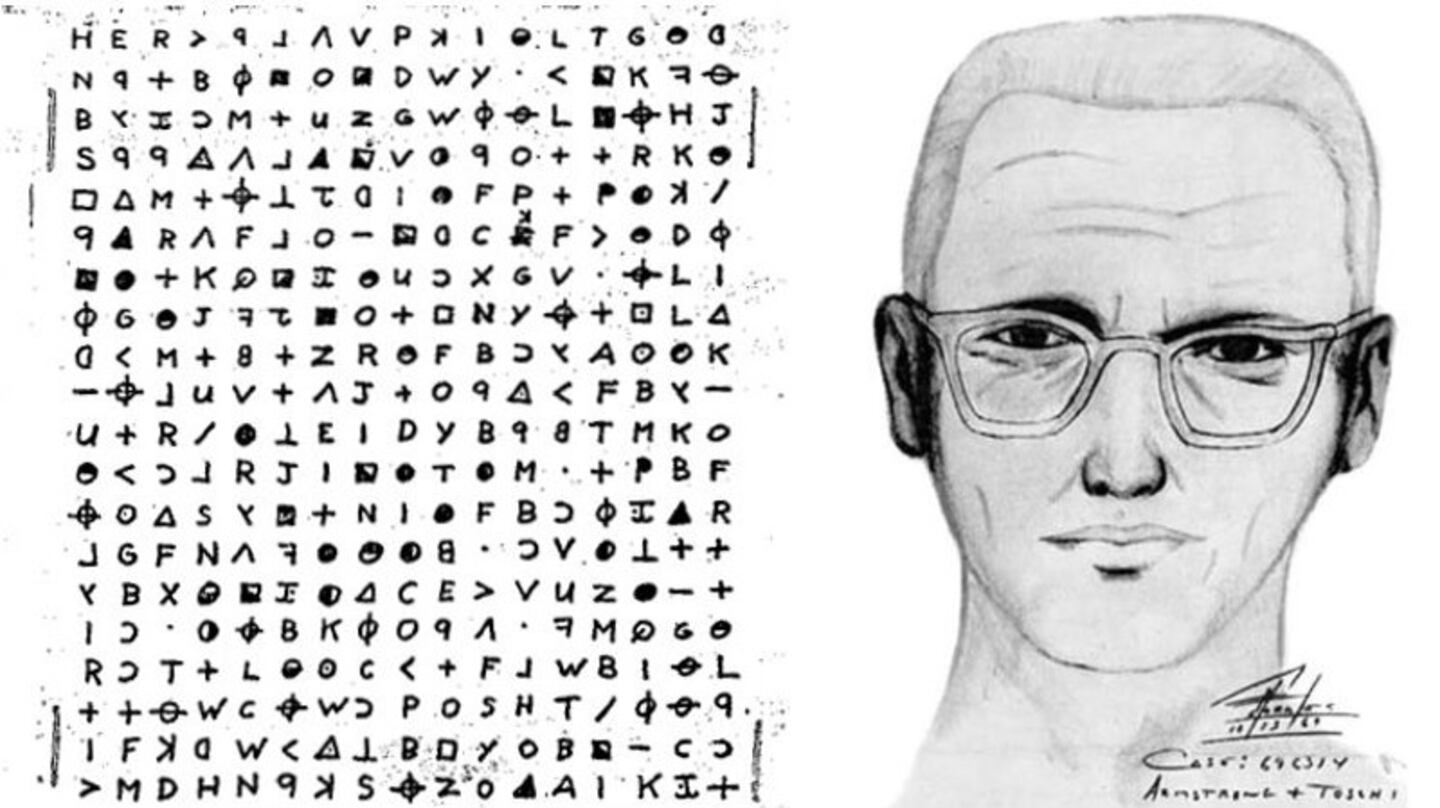VALLEJO, Calif. — Learning the identity of the infamous Zodiac Killer could come down to traces of DNA left behind on 50-year-old stamps.
Police investigators in Vallejo, California, have sent two envelopes that contained letters from the elusive serial killer to a private lab, the Sacramento Bee reported Wednesday. They hope that advanced testing techniques will result in a full DNA profile of the elusive killer, who killed at least five people and injured two others in the late 1960s.
The results of the DNA testing could be completed in a few weeks, the Bee reported.
Investigators in the early 2000s developed a partial profile of the killer using saliva found on the back of a stamp on one of the Zodiac's letters, in which he taunted police and reporters at the San Francisco Chronicle and other newspapers. The Chronicle reported that the partial profile could not rule anyone in as a suspect, though it did rule out a longtime suspect, Arthur Leigh Allen, in 2002.
With a full DNA profile, cold case investigators could potentially find a suspect using public genealogy sites, as detectives did last month with Joseph James DeAngelo Jr., who is accused of being the Golden State Killer. DeAngelo thus far has been charged with eight of the 12 homicides attributed to the infamous rapist and killer.
that the Zodiac, who is remembered for his cryptic letters and coded messages, did not leave DNA at any of his crime scenes. The only genetic material in the case comes from the stamps and flaps of the envelopes he used to mail his correspondence.
Solano County investigators say the Zodiac was responsible for the Dec. 20, 1968, murders of David Faraday, 17, and Betty Lou Jensen, 16, who were shot to death as they sat in Faraday’s car in a gravel turnout on Lake Herman Road in Benicia.
, an archive of materials in the case, Faraday was killed as he tried to get out of the car.
Jensen tried to run and was gunned down several feet behind Faraday’s station wagon.
The next attack came on July 4, 1969, when the Zodiac shot Michael Mageau, 19, and Darlene Ferrin, 22, as they sat in Ferrin's car at Blue Rock Springs Park in Vallejo, the website said. Mageau, who survived the shooting, told police that they were approached by a man who pulled into the lot and got out of his own car with a flashlight.
Thinking he was a police officer, the couple got their identification out, but the man fired five shots into Ferrin’s car. The shooter started to leave, but returned when Mageau cried out in pain and shot each victim twice more.
About 45 minutes after the shooting, a man called the Vallejo Police Department and claimed responsibility for the attack. The caller knew the caliber of weapon used in the killing, ZodiacKiller.com said.
He also took credit for the murders of Faraday and Jensen seven months earlier.
It would not be the last time police heard from the man. The Chronicle, the San Francisco Examiner and the Vallejo Times-Herald
from the self-proclaimed killer on July 31 that contained details of the crimes that only the killer could have known.
Each letter also contained one-third of a cipher that, if solved, he claimed contained his true identity,
. He demanded that the cipher be printed on the front page of each paper, or he would kill a dozen people that weekend.
Though the threatened killings did not take place, all three portions of the cipher were eventually published. Police officials were unable to decipher the code in the killer’s letters, but a Salinas couple, Donald and Bettye Harden, cracked it.
The solved cipher began, “I like killing people because it is so much fun.” It went on to say killing humans was more fun than killing wild animals because man is the most dangerous animal of all.
The writer of the letter also said he would not tell investigators who he was because they would “try to slow (him) down or stop (his) collecting of slaves for the afterlife.”
A few days after the three letters with the ciphers were sent, the killer sent another letter to the Examiner. The letter, which began, “Dear Editor, This is the Zodiac speaking,” was the first time the killer used the moniker.
Two months after the Ferrin-Mageau shooting, Bryan Hartnell, 20, and Cecelia Shepard, 22, were sitting on a blanket at Lake Berryessa, located in Napa County, when they were approached by a gun-wielding man wearing a homemade hood. The man told the couple he was an escaped prisoner and needed money and a car to flee to Mexico.
Though Hartnell offered the man his keys and cash, the man did not take them. Instead, he tied the couple up and stabbed them repeatedly before walking away.
Hartnell survived, but Shepard later died of her wounds.
As in the previous attack, police in Napa received a call about an hour after the attack from a man claiming responsibility for the crime,
. He also left a cryptic message on the victims’ car door.
See an image of the victims' car door here.
The message gave the date and time of the attack, which he said was committed “by knife,” along with the dates of the previous two attacks. He signed the message with a symbol of a cross overlaid with a circle.
The symbol had also been on the hood he wore as he attacked Hartnell and Shepard. It would go on to become his calling card in his letters to police and the media.
The final slaying definitively linked to the Zodiac was the killing of cab driver Paul Stine, 29, on Oct. 11, 1969, in San Francisco. The killer stole Stine’s wallet and keys, as well as a torn-off portion of his shirt.
Two days after Stine's death, the Chronicle received a letter from the Zodiac taking credit for the killing and threatening to kill schoolchildren as they got off their school buses. The letter also contained a bloody piece of Stine's striped shirt.
Three witnesses near the scene of Stine's shooting told police they were about 60 feet away when they watched a man wipe down the cab before calmly walking away, ZodiacKiller.com reported. They described the man as a stocky white man in his mid- to late 20s with a reddish-brown crew cut and heavy-framed glasses.
Despite wiping the car down, investigators found bloody fingerprints on the car that they believed to be the killer’s.
Police officers en route to the crime scene, who had mistakenly been told the suspect was a black man, spotted a man fitting the description given by the witnesses, but did not stop to talk to him,
.
Though only five slayings have been definitively linked to the Zodiac Killer, he claimed many more killings in his letters. Investigators have also attempted to determine over the years if a handful of unsolved cases were his handiwork.
The earliest of those cases were the murders on June 4, 1963, of Robert Domingos, 18, and Linda Edwards, 17, on an isolated stretch of beach in Santa Barbara County. The teens, who were participating in their high school’s “Senior Ditch Day,” were shot to death.
Similarities to the Zodiac's 1969 attack at Lake Berryessa prompted detectives to believe they could be linked, ZodiacKiller.com said.
Another potential Zodiac slaying is the Oct. 30, 1966, beating and stabbing death of Cheri Jo Bates, 18, in an alley on the campus of Riverside City College. Bates had been studying at the campus library before her death.
Her car was found nearby, intentionally disabled.
A typed letter confessing to the homicide was sent about a month after Bates' death to the Riverside Police Department and the Riverside Press-Enterprise. The letter contained some details of the crime that were not widely publicized, but investigators were never sure if the letter was legitimate, or if it was a hoax.
Detectives in Riverside also had another suspect in the case who was not linked to the other Zodiac killings, though no arrest was ever made.
The Zodiac also took credit for a March 22, 1970, incident in which a woman named Kathleen Johns, 22, and her infant daughter were pulled over near Patterson, California, by a man claiming one of her car’s tires was wobbly. The man offered to fix the tire, but Johns later told police that he made it worse and that after she started driving again, the wheel fell off the car.
Johns said the man stopped to help her and ended up driving her and her daughter around for nearly two hours before she managed to escape. Though investigators have never definitively linked the Zodiac to the case, he wrote a letter to the Chronicle that July claiming that he was responsible.
The Zodiac has also been named as a potential suspect in the Sept. 6, 1970, disappearance of Donna Lass, who vanished from South Lake Tahoe. There was nothing substantial linking the serial killer to Lass, but the 25-year-old nurse lived a few blocks from where Stine was killed in San Francisco.
Though the Chronicle received suspicious letters throughout the remainder of the 1970s, the final letter that investigators attribute to the Zodiac was sent in January 1974. In it, the writer stated that he recently saw “The Exorcist” and thought it was the “best satirical comedy that (he had) ever seen.”
He ended the note with a tally of the murders he claimed he’d committed:
“Me -- 37, SFPD -- 0.”
Cox Media Group








